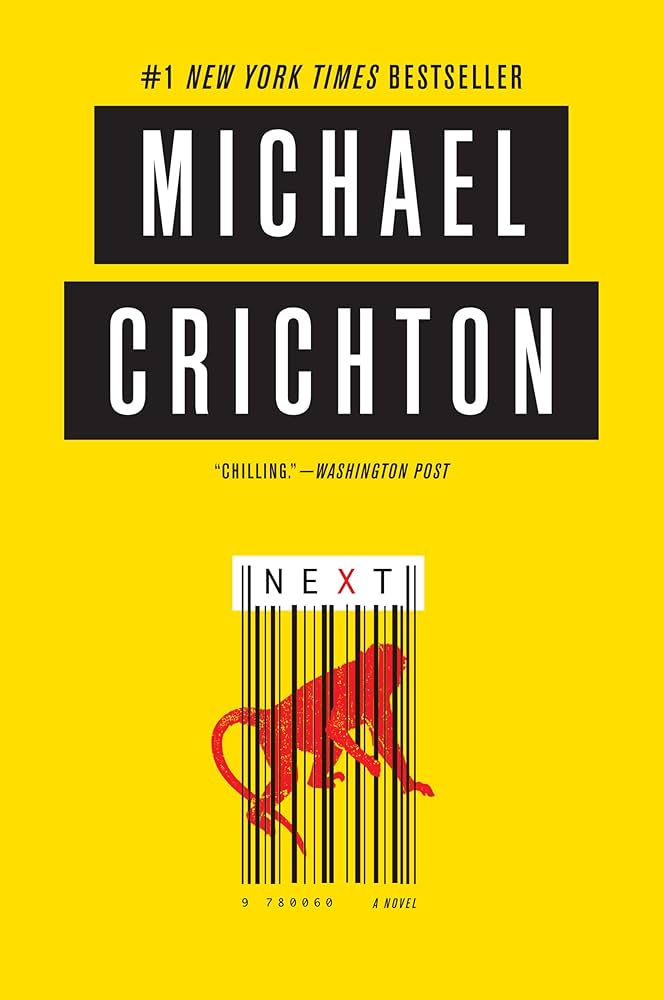In “Next,” Michael Crichton once again plunges readers into the uncharted waters where cutting-edge science collides with ethical ambiguity.Known for his knack for transforming complex scientific ideas into gripping narratives, Crichter’s exploration of genetic science is as provocative as it is thought-provoking. This novel challenges us to consider not only the marvels of genetic research but also the unforeseen consequences that ripple through society. In this review, we will delve into how “next” navigates these murky ethical dilemmas and whether it successfully balances scientific insight with compelling storytelling.
Exploring the Ethical Dilemmas of Genetic Engineering Presented in Next and Their real-World Implications
Beyond the fictional drama, the dilemmas presented resonate with real-world cases, illuminating the fragile balance between innovation and ethics.Consider the following critical areas impacted by genetic technology:
- Gene patenting: Raises questions about accessibility versus exclusivity in medical breakthroughs.
- Designer babies: Forces society to confront notions of equity and the natural spectrum of human variation.
- Dual-use research: Highlights the dangers of scientific knowledge being employed for harmful purposes.
| Ethical Concern | Potential Real-World Impact |
|---|---|
| Gene Ownership | Monopolies on treatment and research |
| Genetic Privacy | Discrimination based on DNA data |
| Bioengineered Species | Ecological imbalances |
Through these lenses, Crichton’s work functions as both a speculative caution and a catalyst for dialog on shaping policies that govern genetic science responsibly.
A Deep Dive into Crichton’s Narrative Style and How It Shapes Reader engagement with Complex Scientific Concepts
Key techniques in crichton’s narrative toolbox include:
- Fragmented storytelling: non-linear timelines that mirror scientific discoveries unfolding unpredictably.
- multidimensional characters: embodying conflicting viewpoints, reflecting societal debates about genetic science.
- Detailed explanatory passages: seamlessly integrated into dialogue or action to avoid exposition dumps.
These techniques work synergistically to create an engaging cognitive experience. Consider the following simplified comparison of reader engagement levels with scientific fiction styles:
| Narrative Element | conventional Sci-Fi | Crichton’s Style |
|---|---|---|
| Scientific Detail | High Density | Moderate & Contextual |
| Reader Immersion | Variable | Consistently High |
| Emotional Connection | Occasional | Strong & Nuanced |
| Concept Accessibility | Challenging | Approachable |
Analyzing the Multifaceted Characters and Their Perspectives on Biotechnology’s Risks and Rewards
Michael Crichton’s Next masterfully brings to life a spectrum of characters whose conflicting views embody the ethical and practical tensions at the heart of modern biotechnology. From ambitious scientists pushing the boundaries of genetic manipulation to corporate players driven by profit, and activists warning against unchecked innovations, each character becomes a lens highlighting distinct perspectives. Their dialogues and actions propel readers into the grey areas where potential breakthroughs clash with fears of unintended consequences.Their multifaceted viewpoints challenge us to reflect on humanity’s relentless pursuit of progress in biotechnology, weighing hopes of curing diseases against concerns over moral boundaries and ecological impacts.
To better illustrate these varied perspectives, the following table summarizes key character archetypes alongside their attitudes toward biotechnology’s risks and rewards:
| Character Type | Role in the Story | View on Biotechnology |
|---|---|---|
| innovative scientist | Driving new genetic experiments | Sees promise in breakthroughs despite risks |
| Corporate executive | Funding and marketing biotech ventures | Focused on profit, less on ethical concerns |
| Bioethicist | Questioning the moral aspects | Warns about societal and environmental costs |
| Activist | Opposing unregulated genetic manipulation | Advocates for strict controls and awareness |
- Curiosity: Drives scientific innovation but risks hubris.
- Commerce: accelerates progress yet can prioritize earnings over ethics.
- Conscience: Urges caution and duty amid rapid advancements.
The Role of Corporate Interests and Legal Battles in Next and Their reflection of Contemporary Science Debates
In Next,Michael Crichton masterfully exposes the tangled web where cutting-edge genetic research meets the unforgiving world of corporate interests. The novel portrays biotechnology firms fiercely guarding their intellectual property, often at the expense of ethical considerations and individual rights. Legal battles erupt not just over patents but over the very essence of life itself, as companies jockey to dominate a field ripe with both promise and peril. These conflicts underscore a modern reality: scientific breakthroughs rarely unfold in isolation but are deeply enmeshed in economic ambitions and political power struggles. Through sharp dialogue and complex characters, Crichton challenges readers to question who truly benefits when science is commodified and human ingenuity becomes a marketplace asset.
Reflecting contemporary debates, the narrative explores critical themes such as:
- Ownership of genetic material: Who holds the rights to modified DNA, and should it be patentable?
- Ethical boundaries in research: Balancing innovation with moral responsibility.
- Clarity and accountability: The difficulty of regulating fast-paced scientific advancements.
These issues resonate beyond the pages, mirroring real-world controversies surrounding CRISPR technologies and biotech patents. Crichton’s fictional legal confrontations serve as a prism through which we can examine the fragile intersection of law,profit,and the rapidly evolving landscape of science.
| Aspect | Corporate Interests | Legal Challenges |
|---|---|---|
| Patenting | Profitable control of genetic sequences | Disputes over novelty and ethics |
| Research Freedom | Drive for competitive advantage | Regulation and liability concerns |
| Public Perception | Image management and marketing | Transparency demands and lawsuits |
Unpacking the Scientific Accuracy Versus Fictional Liberties Taken by Michael Crichton in His Genetic Thriller
Michael Crichton’s narrative in Next masterfully straddles the line between cutting-edge genetic science and imaginative speculation, weaving a tapestry that captivates while simultaneously raising eyebrows among experts. While the novel incorporates genuine scientific concepts-such as gene editing, synthetic biology, and the complexities of CRISPR techniques-it amplifies potential risks and ethical quandaries for dramatic effect. These liberties serve to heighten suspense but occasionally stretch the boundaries of current scientific consensus, especially regarding the speed and ease of manipulating genomes at a large scale. Readers are presented with a world where scientific breakthroughs rapidly outpace regulatory frameworks, a scenario that, although not far-fetched, is certainly accelerated for narrative urgency.
Key scientific elements featured include:
- Gene patents and ownership controversies
- Transgenic organisms with unanticipated effects
- Ethical dilemmas surrounding human germline modification
- Biotechnological espionage and corporate warfare
To visualize Crichton’s balance between fact and fiction, the table below breaks down several plot points alongside their real-world scientific counterparts:
| Plot Device | Scientific Basis | Creative Liberty |
|---|---|---|
| Rapid production of transgenic mosquitoes | current genetic modification is slow and costly | Depicted as near-instantaneous and widespread |
| Gene ownership litigation | Real cases on gene patenting | Exaggerated corporate conflicts and espionage |
| Human germline editing risks | Ethically debated, experimental stage | Portrayed as morally ambiguous and risky |
By intertwining credible science with speculative fiction, Crichton invites readers to ponder not just the “how” of genetic manipulation, but the cascading social and moral fallout that might accompany such power. This blend, while occasionally skirting hyperbole, effectively opens an accessible dialogue on the future trajectory of biotechnology and its unpredictable consequences.
How Next Challenges Readers to Question the Boundaries of Human Intervention in Nature and Genetic Modification
Michael Crichton’s narrative thrusts readers into a world where the boundaries between natural evolution and human manipulation blur alarmingly. As the story unfolds, it becomes evident that the ethical dilemmas posed by genetic modification are as complex as the science itself. Crichton invites us to ponder: when does innovation cross the line into reckless intervention? The novel cleverly exposes the precarious balance between scientific ambition and unintended consequences, revealing how the quest to control nature might unravel the very fabric of life. It challenges assumptions by showcasing a reality where genetic alterations spawn unpredictable behaviors and moral quandaries.
Key provocations woven through the narrative include:
- The ambiguity of ownership and rights over genetically modified life forms
- The ethical responsibility of scientists versus corporate agendas
- the impact of genetic tampering on ecological and evolutionary systems
| Aspect | Crichton’s Exploration |
|---|---|
| Human Control | Illusion of mastery over genetics |
| Ethical Dilemma | Blurred lines between benefit and harm |
| Environmental Impact | Unintended ripple effects on nature |
Examining the Social and Moral Consequences of genetic Research as Portrayed Through Crichton’s Plot Twists
Michael Crichton’s narrative deftly explores the cascading effects of genetic manipulation, highlighting its ripple across societal norms and ethical boundaries. Through his unexpected plot developments, he spotlights the unintended consequences of scientific advancement-not merely technological faults but deep cultural and moral upheavals. Characters caught in the web of genetic experimentation face a host of dilemmas that challenge concepts of identity,autonomy,and justice,effectively illustrating the tension between innovation and responsibility. The novel forces readers to confront questions such as: Who truly owns genetic information? and How does the commodification of life alter social dynamics?
- Cloning dilemmas that unsettle family and legal definitions
- Bioethics entangled with corporate greed and power struggles
- The unpredictable consequences of gene editing on societal equality
Crichton’s expertly woven plot twists also function as cautionary markers on the slippery slope of scientific hubris. By placing biotechnology in a landscape rife with political intrigue and personal betrayal, the story underscores a critical reality: advancements without comprehensive oversight risk amplifying disparity and moral ambiguity. His portrayal invites us to continuously reassess the delicate balance between progress and precaution, using the narrative as a mirror reflecting real-world debates on genetic privacy, exploitation, and the clandestine consequences of playing god.
| Social Impact | Moral Dilemma | Plot Twist Effect |
|---|---|---|
| Displaced legal parentage | Rights of artificially created beings | Reveals hidden identities |
| Unequal access to gene therapy | Bioengineering as privilege vs. oppression | Exposes corporate conspiracies |
| societal fear of genetic chaos | Playing god vs. natural order | Triggers mass paranoia |
Recommendations for Readers Interested in Science, Ethics, and Thriller Genres seeking Thought-Provoking Literature
For those captivated by the intricate dance between cutting-edge science and moral dilemmas, this novel offers a remarkable exploration. It challenges readers to confront the ethical boundaries of genetic engineering with a narrative that’s equal parts thrilling and intellectually stimulating. The story’s multifaceted characters and unpredictable plot twists underscore how scientific advancements can intersect with profound human questions, making it a perfect pick for anyone eager to question the limits of innovation without losing the edge-of-the-seat suspense.
Readers seeking a compelling blend of fast-paced storytelling and weighty philosophical debates will find themselves engrossed by the novel’s layered approach. Below is a snapshot of key themes intertwined throughout the book, highlighting why it stands out in the genres of science, ethics, and thrillers:
| Theme | Aspect Explored | Why It Matters |
|---|---|---|
| Genetic Ethics | Manipulation & Consequences | Raises questions about scientific responsibility |
| Corporate Power | Bioindustry Influence | Examines profit vs. morality |
| Human Identity | Genetics & Free Will | Challenges the essence of individuality |
| Thriller Elements | Suspense & Intrigue | Keeps readers engaged and reflective |
- Philosophical depth embedded in a gripping plot
- Scientific accuracy mingled with imaginative speculation
- Complex characters that embody ethical conflicts
Visualizing the Intersection of Science and Storytelling: Ideas for AI Images inspired by the Themes of Next
To visualize this complex intersection effectively, consider concepts that merge the microscopic with the monumental. For instance, AI could render a close-up of a petri dish evolving into a sprawling ecosystem of digital neurons, a metaphor for how tiny genetic alterations ripple outward to reshape societies. Incorporate elements like lab equipment that morphs into storybook illustrations or gene sequences flowing like ink across ancient parchment-each image a bridge connecting the cold data of science with the warm pulse of human experience. Such compositions can serve as profound conversation starters, capturing the essence of Crichton’s narrative through compelling, layered imagery.
- Hybrid Beings: Creatures blending human and animal genetics in surreal environments.
- Gene Maps as Art: DNA sequences transforming into vibrant abstract patterns.
- Laboratory Fantasia: Scientific instruments intertwined with fairy tale motifs.
- Urban biotech Landscapes: Cities designed with living, genetically-modified elements.
| Theme | Visual Element | Symbolic Meaning |
|---|---|---|
| Genetic Mutation | Color-shifting DNA strands | Uncertainty and innovation |
| Ethical Dilemmas | Scales balanced over molecule models | Morality in science |
| Human Identity | Fragmented human silhouettes | Blurred boundaries of self |
| Scientific Progress | Light emerging from microscopes | Hope and consequence |
Understanding Michael Crichton as a Visionary Author Who Blends Science, Suspense, and Ethical Inquiry seamlessly
Michael Crichton’s genius lies in his unparalleled ability to interweave complex scientific ideas with gripping narrative tension. He takes readers on a journey where the boundaries between fact and fiction blur, making scientific concepts not only accessible but also thrilling. In works like Next, Crichton doesn’t simply present science as a backdrop; he transforms it into a living, breathing entity that challenges both characters and readers to question the rapid advancements and their ramifications. This seamless blend invites the audience to engage with ethical dilemmas posed by cutting-edge technology, making each story an exploration of humanity’s relationship to its own creations.
- Science as storytelling: Crichton uses real scientific theories as the foundation for his plots, ensuring authenticity without sacrificing excitement.
- Suspense-driven inquiry: Ethical questions surface naturally, embedded within the narrative’s tension rather than feeling forced or didactic.
- Human complexity: Characters wrestle with moral ambiguity, reflecting the broader societal debate around scientific progress.
| Aspect | Crichton’s Approach |
|---|---|
| Science | Grounded in current research,extrapolated realistically |
| Suspense | Layered,with twists rooted in ethical decisions |
| Ethics | Central theme,forcing confrontation with consequences |
Next by Michael Crichton offers more than just a thrilling narrative; it serves as a thought-provoking mirror reflecting the complex and often unsettling world of genetic science. Through its provocative storytelling, the novel challenges readers to grapple with ethical dilemmas and the unpredictable consequences of scientific advancement. Whether you come away inspired, uneasy, or simply entertained, Next undeniably leaves a lasting impression-inviting us all to consider where the future of genetics might lead.







